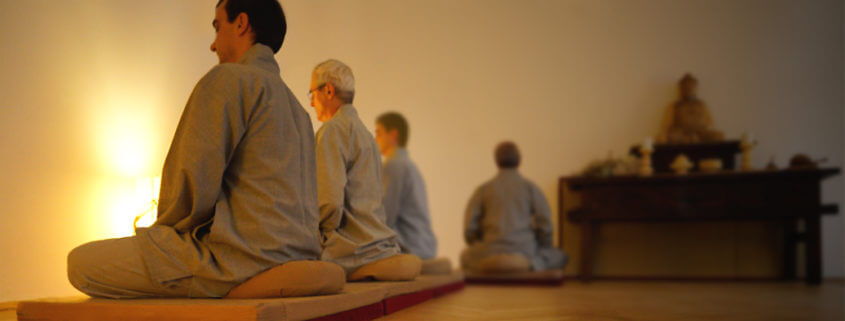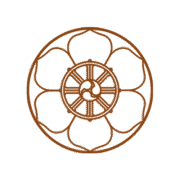
Meditation Essentials
At the heart of the Kwan Um School of Zen are four formal practices, each offering a pathway to clarity and compassion. These time-honored practices are shared in Zen centers and diverse communities around the world, including universities, hospitals, prisons, and interfaith gatherings.
1. Sitting meditation
Posture
There are some rules that apply to all different sitting postures:
The spine should be straight, the shoulders are taken back a bit and stay relaxed. The ears are in line with the shoulders, the eyes remain half open, the view resting on the ground about half to one meter in front of us. The left hand is placed in the right, the palms face up, the fingers of the two hands are on top of each other. The hands form an oval, the thumbs are up, they touch lightly at the tips. The center of the oval should be in front of the center (Japanese Hara, Korean Danjeon = Energy Garden). The gentle touch of the thumb and the shape of the oval help to keep our awareness. If it is lost and we begin to doze, our hands open, the thumbs or hands fall down. When we begin to cramp, the thumbs are pressed against each other. By this we recognize our mind going astray and can come back to our practice.
Sitting meditation means to sit still and only follow the rhythm of our breathing. The only allowed posture change during sitting meditation is getting up. Another change of posture while seated is not helpful, otherwise you would want to change your posture all the time. Getting up gives the body a chance for a brief relaxation as you continue your awareness right in the moment.
There are several meditation sitting positions:
- Full lotus position, the legs are crossed so that the feet rest on the thighs
- Half lotus position, only one foot rests on the opposite leg
- Burmese style, the feet lie against each other on the ground and not on the thighs
- You can also sit on a meditation bench or take the pillows between your legs, so that the knees are not so heavily loaded.
- Another option is sitting in a chair.
In all sitting positions, it is important to take a stable posture. This is best achieved with both knees and buttocks touching the floor (or cushion / chair). For meditation, however, inner sitting is crucial, not the outer form. It is only a tool to find inner peace.
Breathing
Breathing is of great importance in all meditation techniques. Breathing takes place through the nose with closed mouth. We breath with the diaphragm and the lower abdomen. That means, during inhalation, the lower abdomen expands easily and on the exhalation, it relaxes again. The exhalation is about twice as long as the inhalation. This takes some practice and helps to bring energy from the head and chest region to our energy center (Danjeon). It should be a relaxed, natural and quiet breath: the breath should flow freely and not be controlled at will. “The breath is breathing itself.”
Mind
In Buddhism there are many different techniques and every technique is wonderful and helps us to experience our life as it is. In Zen, people sometimes count their inhalations. In our tradition, we usually start with a very simple phrase, question or mantra that can be linked to the breathing pattern. Keeping a question like “Who am I?” or “What is this?” on the inhalation and “don’t know” on the exhalation is called “Hwadu” in Korean. If we ask these questions sincerely, then we come to a point where we know no answers. This Don’t know mind is the mind before thinking, where no concepts and constructs obscure reality. Let all thinking, all opinions and desires just go and return to this questioning mind constantly.
Introduction – try it
Sit stable on your buttocks. The spine rises from the pelvis, upright, stable and at the same time relaxed. Imagine a thread on the head that pulls the highest point of the head towards the sky. The chin is pulled lightly against the chest.
The eyes are open, your gaze rests about ½ to 1 meter in front of you on the floor. The tongue lies softly behind the upper incisors. The shoulders are relaxed. The hands form a circle just below the belly button. The left hand rests in the right and the thumbs touch on the fingertips.
The breath is relaxed and slows down. Feel how the lower abdomen expanding with the inhale and the lungs fill with air. Feel how the lower abdomen relaxes with the exhale and the air flows through the nose evenly. Let your breath flow freely and naturally.
Relax the neck. Relax the jaw. There is nothing to do and no thought is so important that it should be thought. Let the thoughts come and go as if they were clouds in the sky. Hear every sound that comes up – and let it go. Be aware of your relaxed body – and let it go. Drop all feelings and thoughts into the area below the navel, which we call Danjeon, Energy Garden. Keep a don’t know mind by returning to the moment and breath again and again.
2. Chanting
In our Zen centers, people live together and practice together. At first, people come with strong opinions, strong likes and dislikes. For many people, chanting meditation is not easy: much confused thinking, many likes, many dislikes and so on. However, when we do chanting meditation correctly, perceiving the sound of our own voice and the voices all around us, our minds become clear. In clear mind, there is no like or dislike, only the sound of the voice. Ultimately, we learn that chanting meditation is not for our personal pleasure, to give us good feeling, but to make our direction clear. Our direction is to become clear and get enlightened, in order to save all beings from suffering. So when you are chanting, you must perceive the sound of your voice: you and the universe have already become one, suffering disappears, true happiness appears. This is called nirvana. If you keep nirvana, your mind is clear like space. Clear like space means clear like a mirror. Red comes, red. White comes, white. Someone is happy; I am happy. Someone is sad; I am sad. Someone is hungry; give them food. The name for this is great love, great compassion, the great bodhisattva way. That also means great wisdom. This is chanting meditation, chanting Zen.
Zen Master Seung Sahn
3. Bowing
Bowing practice means that your body and your mind become one very quickly. Also, it is a very good way to take away lazy mind, desire mind and angry mind… Some people cannot sit. Sometimes due to health limitations or they have too much thinking, and if they sit, they cannot control their consciousness. Then, bowing is very good. Using your body in this way is very important…Our bowing takes away our karma mind, our thinking mind, and return to this moment very clearly, want to find my true nature and save all beings from suffering. This is why bowing practice is so important. If somebody has much anger, or much desire, or lazy mind, then every day, 300 bows, or 500 bows, even 1,000 bows, every day. Then their center will become very strong, they can control their karma, take away their karma, and become clear. This helps the practitioner and this world.
Zen Master Dae Bong
Instructions:
- Start in a standing position with the feet together, and the hands in hapchang.
- Drop gently to your knees, but still stay in a vertical position sitting on your heels with your hands in hapchang.
- Drop forward to all fours so that the right hand is in front of the right knee and same for left.
- Rock back and down so that your rear is touching your heels and your forehead is touching the floor. In this position, your hands should be turned over (palms up), touching the mat next to your ears and your left foot should be crossed over the right one. Remain for a moment in this position.
- Rock forward and up so that you return to the “all fours” position.
- Sit back on your heels and come to a vertical position with your hands in hapchang, resting on the balls of your feet again.
- Return to the upright standing position.
If you are having trouble with the exercise, you can replace some or all of the bows or prostrations with standing bows.
4. Kong-an
Koans (chinese: kung-an, korean: Kong-an, means “public case”) have their origin in the records of encounters between Zen practitioners in ancient China. Koans are probably best known for the unusual, seemingly non-rational quality of their questions, language and dialogues, and are not meant to be studied, analyzed or approached conceptually. The koan is a tool that helps us to return to our don’t-know-mind so that we can only clearly perceive and function. It is an essential part of Zen practice.
Joju once asked Master Nam Cheon, “What is the true way?” Nam Cheon replied, “Everyday mind is the true way.” “Then should I try to keep it or not?” Nam Cheon said, “If you try to keep it, you are already mistaken.” “If I do not try to keep it, how can I understand the true way?” Nam Cheon replied, “The true way is not dependent on understanding or not understanding. Understanding is illusion; not understanding is blankness. If you completely attain the true way of not thinking, it is like space, clear and void. So why do you make right and wrong?” Joju heard that, and got enlightenment. What did Joju attain?
Often, Zen students want to “keep it”. That is a big mistake. Zen means when you are doing something, just do it. You already know that understanding is illusion. Don’t be attached to your understanding! Correct practice means “How does your understanding get digested and become wisdom?” That is true everyday mind. So why make kong-ans? Since everybody understands too much, we must use understanding medicine. What did Joju attain? If you open your mouth, it’s already a mistake. But if you are not thinking, the answer is pure and clear, always in front of you.
Zen-Meister Seung Sahn
While many find these practices beneficial, we kindly remind participants that meditation is not a substitute for necessary medical or psychological treatment. We encourage everyone to engage mindfully and take personal responsibility for their well-being.

